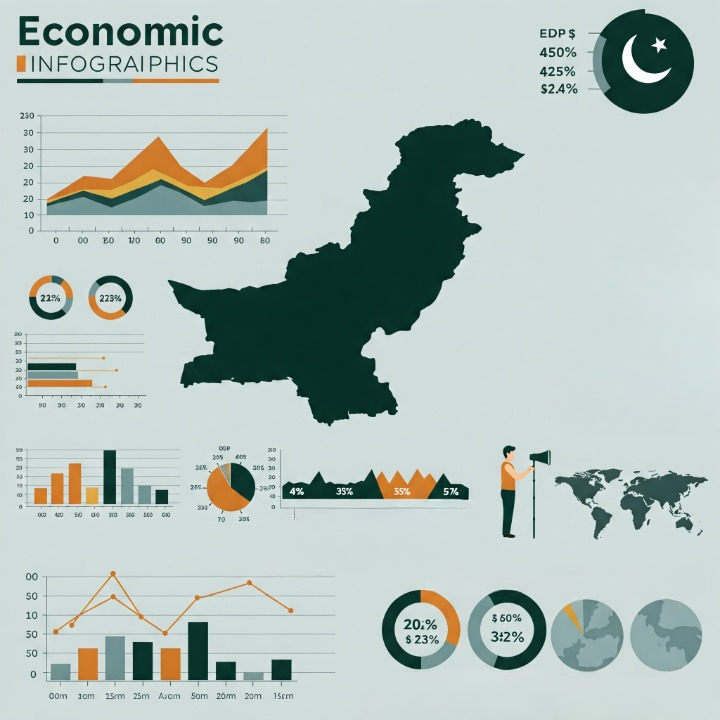
Pakistan’s economy has shown positive developments during FY2025, as highlighted in the Economic Update and Outlook – February 2025, released by the Finance Division, Government of Pakistan (finance.gov.pk). The report provides a detailed analysis of macroeconomic indicators, revealing encouraging signs in fiscal consolidation, external sector stability, and inflation control. However, several challenges remain, requiring prudent policy management.
Macroeconomic Stability and Growth Prospects
The economic update underscores an improvement in economic activity, particularly in export-oriented industries, despite sluggish growth in Large-Scale Manufacturing (LSM). Notably, remittances and Foreign Direct Investment (FDI) inflows have strengthened, boosting investor confidence. The Pakistan Stock Exchange (PSX) has also performed well, reflecting increased market optimism. These factors collectively suggest a positive economic outlook for the coming months.
Agriculture Sector: Mechanization and Productivity Gains
Agriculture remains a key driver of Pakistan’s economy, and government initiatives to enhance farm productivity are yielding results. Wheat sowing for Rabi 2024-25 covered 22.07 million acres, with projected production of 27.9 million tonnes. Additionally, agricultural credit disbursement increased by 8.5%, supporting investment in farm mechanization and input utilization. Fertilizer offtake has also risen, contributing to higher productivity expectations.
Industry and LSM: Mixed Performance
The Large-Scale Manufacturing (LSM) sector has seen a monthly recovery of 19.1% in December 2024, but year-on-year (YoY) LSM output declined by 3.7%. Despite this, certain industries such as automobiles, transport equipment, textiles, and cement have demonstrated resilience, indicating potential for gradual sectoral recovery. The cement industry reported 14.1% growth in dispatches, while automobile production increased by 28.9%. This signals emerging industrial momentum, though challenges remain in sustaining growth.
Inflation and Monetary Policy Adjustments
A sharp decline in inflation has created a stable financial environment, enabling the State Bank of Pakistan (SBP) to gradually reduce policy rates. CPI inflation dropped to 2.4% in January 2025, compared to 28.3% in January 2024, reflecting effective fiscal management and stable commodity prices. Key contributors to this inflation decline include lower food prices and controlled energy costs. However, housing, transport, and education costs remain high, requiring further attention.
Fiscal Consolidation: Revenue Growth vs. Expenditure
Pakistan’s fiscal position has improved, with total revenues growing by 42.5% in Jul-Dec FY2025. Notably, non-tax revenue increased by 83%, driven by higher earnings from SBP profits, petroleum levies, and natural gas surcharges. Meanwhile, tax revenue also grew by 26.2%, signaling stronger tax collection efforts. Despite a 22% rise in total expenditures, the fiscal deficit has reduced to 1.2% of GDP, compared to 2.3% last year. Higher revenue growth relative to expenditure increase has helped achieve a primary surplus, indicating fiscal consolidation success.
External Sector: Trade and Current Account Balances
Pakistan’s external sector stability has improved, with the current account posting a surplus of $682 million (Jul-Jan FY2025), compared to a deficit of $1.8 billion last year. Exports increased by 7.6%, reaching $19.2 billion, while remittances showed robust growth. However, imports also rose by 10.9%, widening the trade deficit to $14.1 billion. Despite this, foreign exchange reserves remain stable, and IT exports have grown by 26.5%, highlighting the potential of Pakistan’s digital economy.
Key Takeaways and Policy Implications
- Encouraging Growth Signs – Positive trends in agriculture, remittances, and fiscal consolidation provide an optimistic economic outlook.
- Industry Revitalization Needed – The LSM sector requires continued policy support and industrial incentives to sustain growth.
- Inflation Control Success – The significant drop in inflation suggests monetary policy effectiveness, but cost-of-living challenges persist.
- Fiscal Reforms on Track – The increase in revenues and reduction in deficit indicate fiscal discipline, though expenditure control remains critical.
- External Sector Stability – Improved current account balance and growing IT exports highlight the importance of trade diversification and digital growth.
Conclusion
Pakistan’s economic outlook for 2025 reflects promising developments in agriculture, revenue growth, external sector stability, and inflation control. However, LSM recovery, expenditure management, and long-term investment strategies will determine sustained economic resilience. Policymakers must focus on industrial growth, fiscal prudence, and trade expansion to ensure consistent economic progress in the coming years.
